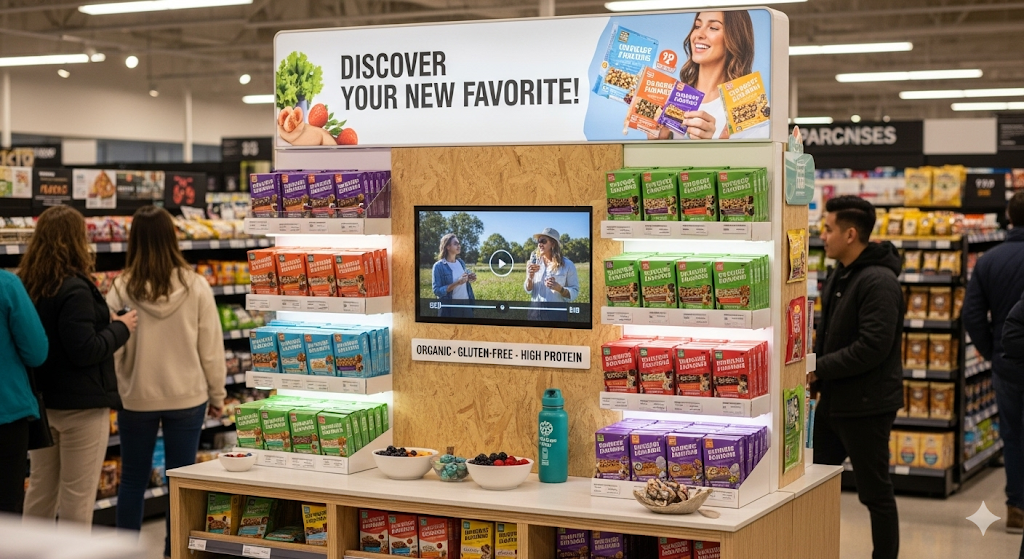Designing for Impact: 5 Keys to High-Converting POP Displays

In an ever-crowded retail environment, capturing attention at the moment of decision is essential. Prepress Design Services play a pivotal role in translating creative concepts into flawless retail fixtures that drive conversions. From structural engineering to color calibration, every detail impacts shopper engagement and retail display design. By aligning production workflows with strategic point of purchase displays, brands can create immersive experiences that resonate with consumers and boost sales.
What makes a POP display high-converting?
High-converting POP displays combine visual appeal, clear messaging, and seamless functionality to influence buying behavior. They interrupt shopping routines with compelling graphics while guiding the eye to key product features. Effective displays integrate data insights—such as dwell time and sales lift—to continually refine their impact. Understanding these dynamics is the first step toward designing displays that truly drive results.
Aligning objectives with shopper behavior
POP displays must reflect precise marketing goals, whether to launch a new product or clear seasonal inventory. By mapping display messaging to customer journeys, brands ensure each fixture delivers the right prompt at the right moment. Analytics from retail partners and in-store sensors inform these alignments, turning abstract objectives into concrete design elements. This strategic approach elevates point of purchase displays from static signage to dynamic sales drivers.
Role of visual merchandising
Visual merchandising bridges product placement and environmental cues to enhance shopper engagement. Effective POP displays employ color psychology, directional graphics, and strategic lighting to guide shoppers along curated purchase paths. These techniques amplify brand storytelling within the retail environment, encouraging impulse buys and reinforcing brand prestige. When combined with retail display design best practices, visual merchandising elevates every point of interaction.
1. Know the audience and shopper psychology
Designing a display without audience insight is like shooting in the dark. Brands must segment shoppers by demographics, purchase intent, and lifestyle preferences to craft resonant displays. Personas inform both the visual language and structural choices—an athletic audience might respond to dynamic lines and bold typography, whereas a luxury segment seeks refined finishes. This audience-centric approach ensures that every display feels personally relevant and persuasive.
Segmenting by demographics and purchase intent
Accurate segmentation starts with retail sales data and shopper surveys. Segment definitions—such as millennials seeking sustainable goods or parents looking for family essentials—influence everything from display height to graphic content. By tailoring displays to specific segments, brands maximize relevance and drive stronger shopper engagement. This precision in design directly translates to higher conversion rates at the point of purchase.
Emotional triggers and engagement tactics
Emotional triggers—like nostalgia, curiosity, or urgency—can tip the balance between browsing and buying. Displays that integrate interactive elements, tactile samples, or short video loops stimulate multiple senses and deepen engagement. Simplified QR prompts or NFC tags, for instance, blend physical and digital touchpoints, inviting shoppers to explore further. These tactics create memorable brand interactions that extend beyond the store.
2. Craft clear, compelling messaging and visual hierarchy
A cluttered display dilutes its own message. Prioritizing concise headlines, prominent product imagery, and clear calls-to-action ensures shoppers grasp the core offer in seconds. Visual hierarchy—achieved through scale, contrast, and whitespace—guides the eye to key selling points. When message and hierarchy align, displays not only attract attention but also convert it into decisive action.
Brand storytelling and product positioning
Effective displays tell a story within just a few words and images. Positioning statements—like “Eco-Friendly Cleaning Power” or “Limited-Edition Flavor”—must anchor the narrative, with supporting bullets or icons reinforcing benefits. By embedding brand values into the display copy, brands cultivate trust and differentiate themselves from generic shelf signage. This narrative layering elevates point of purchase displays into immersive micro-campaigns.
Typography, color, and lighting
Typography choices—from bold sans-serif headlines to elegant serifs—set the tonal foundation of a display. Coupled with a strategic color palette, type guides shopper emotions and brand perception. Integrated lighting—such as LED backlights or spotlights—adds depth and draws focus to key elements. These design decisions, when executed precisely, amplify shopper engagement and reinforce retail display design objectives.
3. Select optimal materials and fabrication methods
Material selection impacts both aesthetics and durability. Standard options include corrugated cardboard for cost-effective campaigns, acrylic for high-clarity showcases, and metal for a premium finish. Each material carries unique strengths and challenges, from print fidelity to assembly weight. Understanding these trade-offs is essential to balancing cost, sustainability, and in-store longevity.
Comparing substrate options
Different substrates offer varying levels of rigidity, print quality, and environmental impact. Brands often test prototypes in real store conditions to evaluate how materials weather foot traffic and lighting variations. These prototype insights help refine material choices before large-scale rollouts. The right substrate not only supports structural goals but also enhances the perceived value of the merchandise.
| Material | Pros | Cons |
| Cardboard | Lightweight; cost-effective | Less durable over time |
| Acrylic | High clarity; premium feel | Higher cost; heavier |
| Metal | Robust; reusable | More expensive; complex |
| Corrugated PL | Sustainable; versatile | Limited print resolution |
Printing techniques for retail displays
Print fidelity and color consistency depend on advanced techniques. Digital UV printing offers sharp graphics and quick turnarounds, while lithography delivers rich, nuanced colors for high-volume runs. Trade-off decisions hinge on project scale, budget, and timeline. These choices underpin the overall impact of point of purchase displays and ensure alignment with retail branding.
In many cases, brands rely on Wide Format Printing partners to achieve large-scale graphic applications. This approach ensures seamless visuals across expansive panels and endcap displays.
4. How do Prepress Design Services ensure structural integrity and ease of assembly?
Prepress Design Services guarantee that design files translate flawlessly into manufacturable components. This critical phase bridges creative concepts and production realities by validating dielines, confirming material compatibility, and correcting color profiles. Through rigorous file checks and virtual mockups, potential issues—such as improper bleeds or unsupported fonts—are identified before fabrication. The result is a display that assembles smoothly and performs reliably on retail floors.
Designing for durability and modularity
Modular display systems allow for flexible configurations across multiple locations or seasonal campaigns. Durable components—like reinforced corners and secure locking tabs—minimize damage during shipping and restocking. Brands also integrate interchangeable graphic panels, enabling quick messaging updates without rebuilding the entire fixture. These modular strategies reduce long-term costs and accelerate campaign turnarounds.
Knockdown designs and on-site assembly
Knockdown designs ship flat, saving on freight costs and simplifying storage. Prepress Design Services produce clear assembly instructions—often with numbered tabs and QR-linked video tutorials—that streamline in-store setup. Retail teams can deploy these units with basic tools in minutes, reducing labor expenses. This frictionless assembly process supports rapid campaign launches and consistent brand presentations.
5. Measure performance and iterate for continuous improvement
A display’s value emerges through measurable impact on shopper behavior. Tracking metrics—such as units sold, uplift percentage, and average dwell time—reveals which design elements resonate. Brands integrate bar-code scanning data, in-store cameras, and loyalty program insights to capture this information. By closing the feedback loop, teams refine display designs for maximum ROI.
Tracking sales lift and dwell time
Point-of-purchase displays often generate double-digit sales increases compared to standard shelving. Monitoring uplift involves comparing baseline sales to performance during display deployment. Dwell-time studies, powered by overhead sensors, reveal which areas of the display attract the most attention. These combined insights fuel smarter decisions in subsequent design iterations.
| Metric | Description | Benchmark |
| Sales Lift (%) | Percent increase vs. baseline sales | 20–50 |
| Dwell Time (sec) | Average time spent near display | 15–30 |
| Interaction Rate (%) | Shopper engagement with display | 5–15 |
Many brands rely on Print Fulfillment Services to handle inventory, kitting, and distribution, ensuring consistent performance measurement across regions.
Integrating in-store marketing and cross-channel consistency
Successful retail campaigns unify physical displays with digital touchpoints. QR codes on displays direct shoppers to product videos or purchase pages, while social media tags encourage user-generated content. This omni-channel synergy amplifies reach and reinforces messaging, making each display a hub of engagement.
Balancing POP and POS strategies
Point-of-purchase (POP) displays focus on interrupting shopping paths in aisles and endcaps, whereas point-of-sale (POS) units target final impulse buys at checkout. Together, they create a layered marketing approach—POP to inform and entice, POS to seal the deal. Understanding these complementary roles ensures brands capture value at every stage of the journey.
Manufacturers often partner with Screen Printing specialists for vibrant, durable imagery that withstands high-traffic environments and repeated cleanings.
Leveraging digital and physical channels
Interactive screens, NFC triggers, and augmented reality overlays can transform static displays into experiential zones. In parallel, email campaigns and website banners echo in-store promotions, driving cohesive shopper journeys. Retailers see higher conversion rates when digital and physical messages reinforce each other. This integrated strategy maximizes the return on investment for each display campaign.
For detailed consultations on bringing these strategies to life, interested teams should Contact Us to explore customized solutions and expert guidance in POP display design.
Conclusion
By mastering these five key principles—audience insight, compelling messaging, material excellence, structural precision, and performance analytics—brands can create POP displays that significantly uplift sales. Prepress Design Services ensure every element is production-ready, from perfect dielines to color-accurate proofs. With Albert Basse Associates guiding the process, retailers benefit from comprehensive expertise in retail display design and shopper engagement. Leverage these insights to elevate your point of purchase displays into high-impact marketing assets.
FAQs
What is the difference between POP and POS displays?
POP displays are positioned throughout the store to attract attention during browsing, while POS displays sit at or near the checkout to prompt last-minute purchases. Both serve distinct functions in the shopper’s journey but work best when coordinated in a unified strategy.
How long does it take to design and produce a POP display?
The timeline varies by complexity and materials but typically ranges from four to eight weeks. This includes concept development, prepress file validation, prototyping, production, and shipping. Modular designs and experienced partners can shorten lead times.
How do Prepress Design Services improve POP display quality?
Prepress Design Services validate artwork files for accurate dielines, bleed, color profiles, and material compatibility. By catching errors early, they prevent costly revisions and ensure that printed graphics align perfectly with structural components.
What materials are best for durable point of purchase displays?
Acrylic offers a premium look and high clarity, metal provides robust longevity, and reinforced cardboard balances cost with temporary campaigns. Material choice should align with campaign duration, budget, and sustainability goals.
How can I measure the ROI of a POP display?
Key metrics include sales lift percentage, average dwell time near the display, and interaction rates. By comparing performance data before and after deployment—and correlating it with display variants—brands can quantify impact and guide future design decisions.
